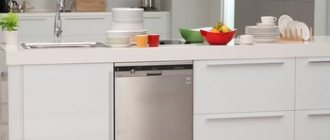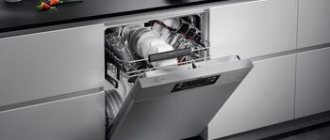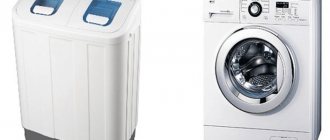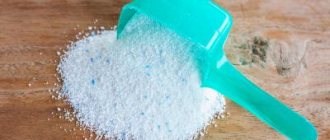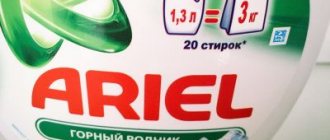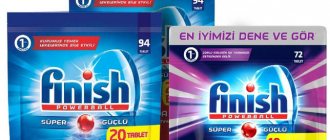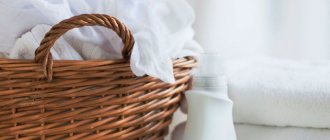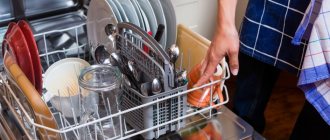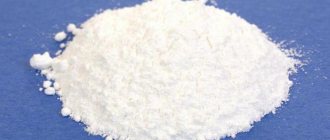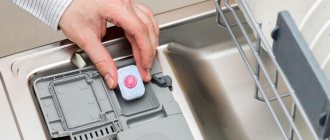Taking care of your child’s healthy nutrition includes not only the correct selection of healthy products, but also the use of high-quality and safe detergent for washing children’s dishes. Careful study of the label and awareness of the permissible amount of harmful components in kitchen household chemicals will help you make an adequate purchasing decision.
- Differences between children's dishwashing detergents and classic ones
- How to choose the safest product?
- Rating of products for hand washing
- For dishwasher
- Expert recommendations
Differences between children's dishwashing detergents and classic ones
Manufacturers of household chemicals are developing a separate line of children's products that differ from classic ones in safety and environmental friendliness.
The composition of a detergent suitable for a child varies:
- the presence of safe surfactants (surfactants) based on natural components;
- absence of aggressive components (phenols, parabens, etc.);
- hypoallergenic;
- good washability;
- no strong smell;
- the presence of disinfectant bleaches.
All these criteria must be taken into account in order to protect the baby’s body from the harmful effects of chemicals.
Set of dishes for PMM
How to choose the safest product?
Compound
Any kitchen detergent contains two main types of components:
- Surfactants are the basis of the product; they clean dishes through foaming.
- Auxiliary elements enhance the effect by breaking down stubborn stains. This type of component includes antiseptics, softeners, coloring and flavoring agents.
The most aggressive components - diethanolamine and chlorine - can lead to headaches and burning eyes. Even if the manufacturer claims that the content of these substances meets acceptable standards, it is better for the baby’s body not to interact with them.
The presence of bleaching reagents – perborate, sodium percarbonate – is allowed. Their function is to disinfect dishes.
An important indicator of the safety of the product is its rapid rinsing. Remaining on the surface of the dishes, surfactants enter the child’s stomach with food. According to GOST, the residue of substances on the plates cannot exceed 0.1-0.5 mg/dm³.
Expert opinion
I work in the household appliance repair industry. Extensive experience in restoring washing machines and dishwashers.
Ask a Question
It is better to give preference to more expensive products, since their production uses surfactants obtained directly from natural raw materials, such as cocoamidopropyl betaine, lauramidopropyl betaine.
Safety
There are two types of surfactants:
- ionogenic (anionic, cationic and amphoteric);
- nonionic.
Anionic substances are considered the most dangerous. They are effective in cleaning dishes, but are harmful to humans and the environment. Amphoteric and nonionic surfactants are biodegradable and relatively harmless.
Often, manufacturers indicate only the percentage of substances in the composition without specifying information about the type of components. In products for children, the amount of surfactants cannot exceed 15%, the ideal option is 5%.
Smell
It is recommended to wash children's dishes with a product that has virtually no odor. It is unacceptable to use a product that leaves a persistent aroma on the surface of the plates. Do not buy a product that smells like alcohol or acetone.
Expert opinion
I work in the household appliance repair industry. Extensive experience in restoring washing machines and dishwashers.
Ask a Question
A light fragrance is provided by the inclusion of essential oils. But they can also cause an allergic reaction in a child.
Package
As a rule, bottles of baby dishwashing detergent are made of plastic and equipped with a convenient dispenser. The volume of the container can be from 250 ml to several liters.
Conscientious manufacturers use degradable plastic that is recyclable and does not harm the environment.
Ingredients: what should not be in it?
The safety requirements for dish gels are quite high, since these preparations come into contact with the inner surface of kitchen utensils.
Hand protection
One of the safety conditions is that the drug should not irritate the skin on the hands. This is achieved with soft formulas and the addition of plant extracts.
The acidity level of the detergent according to the current GOST standards should be in the range of 3-11.5 pH. An indicator of 5.5-8 is safe for the skin.
If the pH in the gel is higher than 8, you will have to use rubber gloves.
What's prohibited?
If the composition contains chlorine or heavy metals, the drug cannot be considered safe. Surfactants in the composition are responsible for effectively washing away contaminants.
But not all surfactants are equally harmless. There is a class of nonionic, which do not pose a threat, and ionogenic.
The washing effect is provided by anti-surfactants. They can lead to irritation of the skin of the hands. In terms of effectiveness and quality of washing, surfactants lead as the main active component.
All household chemicals indicate not just the presence of these substances, but also their percentage. For sensitive skin - should be more than 5%.
Optional components: dyes and flavors
The dyes and flavors included in household chemicals meet the standards. If the gel is intended for washing children's dishes, then there may be no flavorings at all, or they will be natural. Dyes are also not recommended in this case.
Regardless of the composition of the detergent, after cleaning from food residues and grease, the dishes should be rinsed very thoroughly.
Rating of products for hand washing
Balm “Umka”
This inexpensive product is even suitable for washing newborn baby items: pacifiers, bottles, toys. The balm works in cold water and is easily washed off from surfaces.
The composition contains no toxic substances or allergens. The product is colorless and odorless. The list of components includes:
- water – 30%;
- sodium chloride and anionic substances – 5-15%;
- plant extract, disinfectant, preservative – 5%.
Balm “Umka”
Babyline
The manufacturer of Babyline phosphate-free detergent assures that it can be used to wash not only baby’s dishes, but also vegetables. The balm has no smell or color. The substance has a thick consistency, so it is consumed economically. The hypoallergenic product consists of:
- distilled water;
- surfactant;
- glucose APG;
- herbal extract;
- food flavoring.
The gel copes well with oily stains and is gentle on the skin of your hands. The type of surfactant is not indicated on the label.
Babyline
AQA baby
The Russian product AQA baby is also suitable not only for washing pacifiers, bottles, plates and toys, but also for fruit. The gel, which has a pleasant fruity aroma, is effective even in cool water.
Product contains:
- water;
- anionic and nonionic surfactants – 3-15%;
- preservative;
- fragrance
The absence of harmful substances, excellent cleansing results, good value for money - all this can be said about “AQA baby”.
AQA baby
Meine Liebe
The German balsam Meine Liebe copes with traces of fatty foods and a waxy film on fruit. The pleasant foam is washed off from the surface without any residue, even with cool water. According to the manufacturer, the product is environmentally friendly and harmless to children. But it is worth noting that its composition exceeds the surfactant norm - 15-30%.
Meine Liebe
"Stork"
All children's household items can be washed with a product such as Stork. Thick colorless gel has bactericidal properties. The manufacturer lists only surfactants obtained from plant components in the composition of the product. In addition, “Aistenka” contains:
- silver ions;
- glycerol;
- chamomile extract.
Gel "Stork"
The best liquids for children's plates
The leader among children's cosmetics for the care of bottles and nipples
Products for the care of baby bottles and pacifiers are subject to special environmental and safety requirements. After processing, not even the smallest particles of chemical elements should remain on the plates. A good product reliably disinfects and cleans even in hard-to-reach places (under silicone gaskets, inside nipples, tubes, in the grooves of screwing mechanisms.)
Eared nanny
Baby dishwashing liquid Eared nannies
Eared nanny
The Eared Nanny gel for washing children's dishes is universal in use, because it can be used to wash plastic and glass, silicone and latex. Also great for cleaning surfaces that a child comes into contact with. Has antibacterial properties. Does not contain dyes. Hypoallergenic.
Inexpensive and, judging by the reviews, the most popular gel.
Advantages:
- Natural chamomile and aloe vera flavors
- Thick consistency
- Dense foam
- Hypoallergenic composition
- Destroys germs
- Works in cold water
Flaws:
Preservatives present (just a little)
AQA Baby
AQA Baby washing up liquid
AQA Baby
AQA baby detergent for washing baby dishes, a special combination of several mild surfactants, effectively removes food stains from baby dishes, pacifiers, etc. At the same time, the product is quickly and easily washed off with water without settling on the dishes. Suitable for washing vegetables and fruits.
Does not irritate the skin of the hands, does not dry the skin. Does not contain “bad” preservatives (formaldehyde, etc.), phosphates and dyes. Does not cause allergies.
Lightweight composition without dyes or fragrances.
Advantages:
- Organic Ingredients
- This product can be used to rinse fruits.
- Designed for plastic, silicone, ceramics
- Rinses off well
- Does not lose quality in cool water
Flaws:
- The liquid mixture runs out quickly
- Not recommended for infants under 6 months
Babyline
Babyline baby dishwashing detergent
Babyline
Natural baby detergent “BabyLine” is made from natural raw materials and components used in food production, therefore it is completely safe for babies from the first days of life. The herbal-based product effectively and gently removes food stains and bacteria from baby dishes, pacifiers, etc.
Without phosphates, does not cause allergies. Environmentally friendly product.
Completely natural composition of plant elements.
Advantages:
- The herbal extract smells nice
- The product disinfects dishes well
- Includes food flavorings (safe)
Flaws:
- There is a small amount of surfactants (chemical compounds, surfactants)
- Cleans worse in cold water
Miene Liebe
Miene Liebe baby dishwashing detergent
Miene Liebe
A safe detergent for washing children's dishes (pacifiers, bottles, sippy cups, etc.) and toys, including plastic, wooden, rubber and metal. Also recommended for washing vegetables and fruits. Easily removes fat even in cold water, removes traces of paraffin and wax from vegetables, fruits and herbs.
Can be used without gloves and does not dry out the skin of your hands. The thick, concentrated gel is economical to use also due to the presence of a dispenser, which helps to effectively dose the product during use.
Eco-concentrate without fragrances, chemical elements, surfactants, dyes.
Advantages:
- Super economical
- Forms thick foam
- Perfectly blocks fat even from frying pans after frying
- Colorless
- Easy to wash off
- You can wash greens and fruits
Flaws:
- Rarely found in stores
- Does not remove old stains or ingrained plaque
Frosch (children)
Frosch baby dishwashing detergent
Frosch (children)
Frosch Baby natural dishwashing balm is specially designed for the needs of new mothers: gentle and at the same time effective removal of milk, cereal and other food residues from baby accessories, such as baby bottles, pacifiers, teethers or toys.
In addition, Frosch baby dishwashing detergent is hypoallergenic, does not contain dyes or fragrances and is ideal for sensitive skin, is completely washed off with water and is absolutely safe for children.
Leader in safety and naturalness of ingredients.
Advantages:
- Suitable for allergy sufferers
- No smell, no color
- Dermatologist approved as safe for skin
- The composition is completely environmentally friendly
- Can you wash newborn bottles?
- Contains provitamin B5
Flaws:
The drug should not be used to rinse fruits and vegetables (due to the vitamin supplement)
Microwave | TOP 10 Best: Rating, Current prices + Reviews
For dishwasher
BioMio tablets
BioMio dishwasher tablets are an environmentally friendly product made in Russia, suitable for washing children’s dishes, and do not contain:
- chlorine;
- surfactant;
- flavorings;
- toxic substances.
At the same time, the product works effectively even in cold water and is consumed economically. Dissolvable tablet wrap keeps hands dry and clean.
In addition, one of the targeted actions of BioMio 7in1 is to prevent the appearance of limescale on the parts of the dishwasher.
BioMio tablets
Jofure
Japanese Jofure powder is completely biodegradable and does not harm the environment. Suitable for washing dishes for the whole family. Among the components of the product you can find:
- Surfactant – 2%;
- softener;
- disinfectant bleach.
The absence of harmful ingredients allows you to safely use this product for your child’s dishes.
Jofure powder
Ecover
The biodegradable tablet Ecover perfectly breaks down fatty stains and does not contain fragrances, sulfates and phosphates. The Belgian product contains:
- water;
- Surfactant – 5%;
- glycerol;
- oxygen bleach.
Safe "Ecover" is suitable for washing household items for newborns, as well as people prone to allergic reactions. The 3in1 product contains regenerating salt and rinse aid and is gentle on dishwasher parts.
Ecover
Klar
Klar organic product is suitable for treating children’s dishes and copes well with various types of dirt. The hypoallergenic product is made from natural ingredients, which is confirmed by the German association DAAB for the fight against allergies and asthma.
Klar
What are detergents made of?
Requirements for the properties and composition of dishwashing detergent differ depending on the purpose of use. If a drug is chosen for a child or adult with allergies, the choice of composition should be especially picky.
All dishwashing detergents must effectively remove dirt and break down fats, as well as remove stubborn dirt. It’s convenient when you can wash dishes even in cool water.
Store-bought dishwashing detergents always consist of several components. Among them we can distinguish basic and additional ones. Children's dishwashing preparations must be marked accordingly.
Basic substances
The cleaning effect of household chemicals is achieved due to the inclusion of surfactants in the composition.
These surfactants are the main active ingredients. They come in several types:
- nonionic – quite safe, as they are biodegradable;
- ionic (ampholytic, cationic, anionic).
Potentially dangerous are surfactants, which not only promote good cleaning of dishes, but can accumulate when they enter the body. This affects the condition of various human organs.
The higher the percentage of surfactants in the composition, the greater the cleaning power of the product. The second side of the coin is that a product with a high percentage of surfactants ceases to be safe.
In order for the gel to be considered safe, the surfactant concentration must be within 5%. Read more about surfactants in detergents in this article.
Additional components
In addition to the basic substances, detergents also contain additional ones. They serve to maintain the consistency of the gel, for a pleasant aroma, to give color, etc.:
- Glycerol. Glycerin is a colorless, viscous substance that can dissolve in water. It is added to gels to soften the skin of the hands when washing dishes, as it forms a protective film and prevents the evaporation of moisture from the skin.
- Plant extracts. Plant extracts can be added to the composition to soften the skin of the hands, lightly aromatize and disinfect. These can be extracts of chamomile, other flowers and medicinal herbs.
- Table salt. Sodium chloride is often added to gels as a thickener. This component allows you to give the gel a suitable consistency for more convenient and economical use.
- Preservatives. Since dishwashing detergents made industrially have a fairly long shelf life, it is necessary to introduce additional components into the recipe that prevent the product from deteriorating. They also prevent pathogenic microorganisms from developing.
- Water. Water is a clear liquid that serves as a solvent for the components of the gel detergent. It is responsible for the liquid consistency and makes up about a third of the volume in most preparations.
- Dyes.
Dyes are used to give the gel a more attractive appearance and hide the not very advantageous original shade. Eco-friendly products may not contain them at all, or they may use harmless food products. - Enzymes. The introduction of enzymes into the composition of products makes it possible to more efficiently eliminate various types of contaminants. Certain enzymes work on specific types of stains. For example, amylase removes carbohydrate marks on dishes, etc.
- Fragrance. Fragrances are used to give products a pleasant aroma. They are included in almost all dishwashing detergents. An exception may be eco-products and preparations. Which are intended for washing children's dishes.
- pH regulators. Detergents are initially alkaline. To adjust their pH level, additional ingredients can be used, most often citric acid.
- Complexing agents (chelates). Polycarboxylates, zeolites and other substances that soften water and prevent the deposition of salts often act as complexing agents. Some complexing agents additionally serve to better remove contaminants.
- Antibacterial substances. Such components prevent the development of microorganisms. These additives make cleaning more hygienic.
- Phosphates. The introduction of phosphates into detergents increases the toxicity of surfactants. These substances are harmful to the body, as they can penetrate into it even through the skin.
Expert recommendations
If you don't trust industrial products, use homemade recipes to create a safe detergent.
For example, mix the following components:
- soda – 250 g;
- borax – 250 g;
- citric acid – 100 g.
Or add to regular glycerin:
- lemon juice – 50 g;
- alcohol – 1 tsp;
- hot water - 3 tbsp. l.
Just mix the ingredients and use. But keep in mind that you should use homemade products in the dishwasher with great care so as not to damage the equipment.
